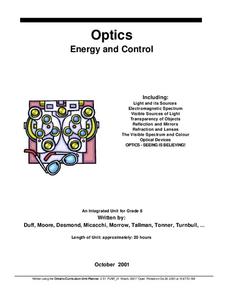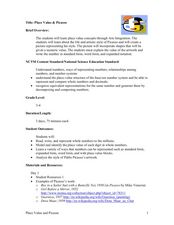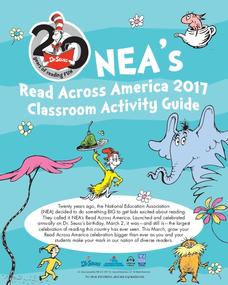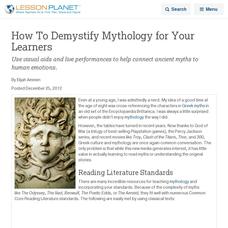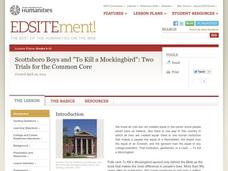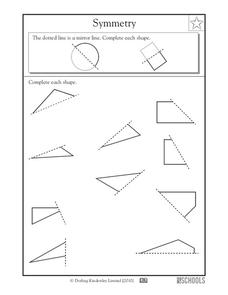Curated OER
Solar Kit Lesson #9 - Properties of Solar Radiation: Reflection, Transmission, and Absorption
Middle school science stars observe and record data on the solar radiation reflected off or transmitted through various materials. They predict properties for various materials, and test their predictions by touch. This lesson becomes...
Curated OER
Energy and Control
Students investigate the question, "how does understanding the properties and characteristics of light help us to enhance our quality of life?". They apply knowledge gained though the unit in order to create an optical device.
Curated OER
First World War Assessment
Here is a really neat assessment, perfect for middle schoolers who have just learned about WWI. The assessment covers the causes and effects of WWI, causes of WWII, the Treaty of Versailles, trench warfare, and key players of the war in...
Curated OER
Place Value & Picasso
Place value to the millions is the focus of this math lesson plan. Third and fourth graders investigate multiple ways to represent a number. They examine place value while studying factual information about Pablo Picasso. Resources are...
Curated OER
Reflexive Verbs
A verb is reflexive when the subject and the object are the same. After introducing your intermediate Spanish speakers to some of the most common reflexive verbs, assign them this sheet for practice. First, they write the reflexive...
Teach Engineering
Solar Power
Elementary schoolers discover how engineers use solar energy to heat buildings. They take a close look at some of the materials used: sand, salt, water, and shredded paper and evaluate the efficiency of each material. An incredible...
Exploratorium
Moire Patterns
By overlapping combs and window screening and by looking at a printed set of consecutively larger circles, learners observe Moire patterns, which provide a visual of what happens during wave interference.
Scholastic
Folk and Fairy Tale Readers: The Ugly Duckling
Engage young readers to explore classic fairy tales with their very own copy of "The Ugly Duckling." With clear illustrations and an easy-to-follow repetitive structure, this printable book is perfect for developing the reading...
Santa Clara County Office of Education
The Rainbow Fish: Activities for Parents to Do with Children at Home
The Rainbow Fish, Marcus Pfister's award-winning story about the joys of sharing, is the inspiration for this resource loaded with fun. Suggestions for language and language arts, math, science, and social studies activities are...
National Education Association
Read Across America Classroom Activity Guide
Celebrate the legendary Dr. Seuss on Read Across America Day with a plethora of activities set to five stories—The Cat in the Hat, The Lorax, Horton Hears a Who, Oh, the Places You'll Go!, and Green Eggs and Ham. Activities...
Fluence Learning
Writing an Opinion: Buddies that Bark or Purr-fect Pets?
Which animal is best for you—a dog or cat? Why? Engage third graders in an opinion writing assessment that prompts them to read facts about both pets, and then write and decide which pet is best for them.
Fluence Learning
Writing About Informational Text: Music and the Brain
Even if you've never picked up a musical instrument, chances are that music has directly impacted your mental and emotional development. Sixth graders engage in a reading activity in which they read two articles on the impact of music on...
Fluence Learning
Writing an Argument: Innovation in America
Are American young people prepared to become tomorrow's leaders in technological innovation, or does an obsession with being cool sidetrack essential skills? That is the question freshmen and sophomores must address in a performance...
Annenberg Foundation
Poetry of Liberation
How do writers use words to protest injustice, challenge the status quo, and shape their own identities? Individuals watch and discuss a video, read author biographies, write poetry and journals, develop a slideshow, and complete a...
Curated OER
What Can We Learn From the Past?
What would future archeologists learn from your scholars' personal belongings? Have them bring in a box of "primary sources" from their home. Discuss the difference between observations and inference, using some of your own items to...
Curated OER
Take-Home Midterm Exam #3
The University of Hawaii has published a vast collection of midterm and final exams for their Physics 152 course. This particular exam offers a variety of assessment methods, and covers the topic of electromagnetic radiation....
Curated OER
How To Demystify Mythology for Your Learners
Use visual aids and live performances to help connect ancient myths to human emotions.
Curated OER
Mathemafish Population
It's shark week! In this problem, young mathematically minded marine biologists need to study the fish population by analyzing data over time. The emphasis is on understanding the average rate of change of the population and drawing...
National Endowment for the Humanities
Scottsboro Boys and "To Kill a Mockingbird": Two Trials for the Common Core
Here's a must-have resource for anyone reading To Kill A Mockingbird or using Harper Lee's award-winning novel in a classroom. The packet contains Miss Hollace Ransdall's first-hand, factual account of the trials of the Scottsboro Boys,...
Curated OER
Emotion Card Games
Emotions come in all shapes and sizes, and can be difficult for young learners or students with special needs to identify. Support them in gaining the valuable social skill of recognizing emotions and understanding empathy with this...
Paul Hamlyn Foundation
Work That Matters: The Teacher’s Guide to Project-Based Learning
Whether new to inquiry-based learning or experienced with its protocols, you'll find much to value in High Tech High's comprehensive guide to project-based learning. Designed for educators, the guide has everything instructors need to...
Exploratorium
Cheshire Cat
Divide your field of vision in two and see what happens when your two eyes behold two different scenes! This is a way to demonstrate to body-systems buffs how the two eyes usually blend pictures to create a three-dimensional view. This...
Curated OER
Symmetry
Do these dotted lines indicate symmetry? Some of them do, and scholars determine which ones in 12 different images. Because some of these are tricky, it may be helpful to have large versions of these shapes printed and cut out. This way,...
Curated OER
Symmetry
Enhance your geometry lesson by working with shapes. Fourth graders follow lines of symmetry to complete ten shapes, most of them currently triangles. Have pupils color each half of their shapes to reinforce the idea of symmetry!
Other popular searches
- Mirror Images
- Convex and Concave Mirrors
- Mirrors Lines of Symmetry
- Light Reflection Mirrors
- Convex Mirror
- Concave Mirrors
- Light Reflection by Mirror
- Curved Mirrors
- Plane Mirrors
- Mirror Writing
- Mirrors Reflections Math
- Mirrors Reflections

